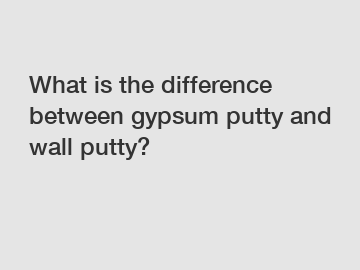What is the difference between gypsum putty and wall putty?
When it comes to home renovations or repairs, we often encounter various materials that are essential for achieving flawless walls. Gypsum putty and wall putty are two popular options that are commonly used for filling cracks, hiding imperfections, and providing a smooth finishing touch. However, many people remain uncertain about the differences between these two products. In this article, we will delve into the characteristics, functions, and best applications of gypsum putty and wall putty, helping you make an informed decision for your next project.
1. Defining Gypsum Putty:
Gypsum putty, also known as gypsum plaster or gypsum-based joint compound, is a versatile material made from gypsum powder mixed with additives, such as binders and fillers. This compound is commonly used for plastering and skimming walls and ceilings, ensuring a strong and durable finish.

Key Features and Benefits:
a) Superior Adhesion: Gypsum putty exhibits excellent bonding qualities, allowing it to adhere securely to various surfaces, including concrete, bricks, and wood.
b) Excellent Crack Resistance: Its unique composition provides enhanced crack resistance, reducing the likelihood of cracks appearing on newly plastered surfaces.
c) Fire Resistance: Gypsum putty is inherently fire-resistant, making it a perfect choice for areas where fire safety is a concern.
d) Smooth Finish: This putty offers exceptional leveling properties, enabling effortless surface preparation for painting or any decorative finishes.
2. Understanding Wall Putty:
Wall putty, on the other hand, is a versatile paste-like material specifically designed for filling and leveling superficial surface imperfections, such as minor dents, bumps, or surface cracks. It acts as a preparatory layer before painting or applying decorative finishes, ensuring a flawless end result.
Key Features and Benefits:
a) Easy Application: Wall putty is user-friendly, offering smooth application due to its creamy consistency, allowing for easy spreading and leveling on the surface.
b) Fast Drying: This type of putty dries quickly, reducing waiting times and making it a great choice for time-sensitive projects.
c) Good Coverage: Wall putty typically provides excellent coverage, minimizing the amount of paint needed for a uniform finish.
d) Effortless Sanding: Its composition allows for easy sanding, ensuring a perfectly smooth surface.
3. The Distinctions:
While both gypsum putty and wall putty serve the purpose of smoothing walls, their primary distinctions lie in their applications, composition, and functional purposes:
a) Purpose: Gypsum putty is primarily used for plastering, skimming, and surface finishing, providing a robust and fire-resistant layer. Wall putty, on the other hand, focuses on surface preparation by repairing minor defects and providing an even base for painting or wallpapering.
b) Composition: Gypsum putty consists of gypsum powder mixed with binders and fillers that enhance its adhesion, crack resistance, and fire resistance properties. Wall putty, in contrast, is typically composed of white cement, fillers, polymers, and additives that impart excellent bonding, smoothness, and quick drying features.
c) Thickness: Gypsum putty is usually applied in thicker layers to fill larger gaps and create a sturdy base for finishing. Wall putty, being designed for minor surface corrections, is typically applied in thinner layers.
4. Best Applications:
a) Gypsum Putty: Ideal for plastering, skimming walls and ceilings, covering large gaps or cracks, and creating a strong and durable base that can withstand structural movements.
b) Wall Putty: Perfect for minor surface repairs, leveling, and smoothing hairline cracks, dents, or unevenness, allowing for a flawless finish before painting or wallpapering.
Conclusion:
In summary, gypsum putty and wall putty serve distinct purposes in home renovations, with gypsum putty providing a more comprehensive range of functions, including fire resistance and crack resistance, while wall putty specializes in surface preparation and minor repairs. By understanding their unique characteristics and applications, you can confidently choose the right material for your specific renovation needs, ensuring a flawless and professional outcome.
For more vae powders uses, hydroxypropyl cellulose wholesale, Flexible redispersible polymer powderinformation, please contact us. We will provide professional answers.

Comments
0